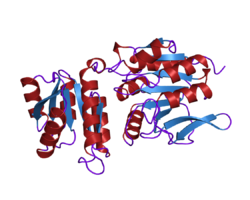Biology:Protein-glutamate methylesterase
| protein-glutamate methylesterase | |||||||||
|---|---|---|---|---|---|---|---|---|---|
| Identifiers | |||||||||
| EC number | 3.1.1.61 | ||||||||
| CAS number | 93792-01-9 | ||||||||
| Databases | |||||||||
| IntEnz | IntEnz view | ||||||||
| BRENDA | BRENDA entry | ||||||||
| ExPASy | NiceZyme view | ||||||||
| KEGG | KEGG entry | ||||||||
| MetaCyc | metabolic pathway | ||||||||
| PRIAM | profile | ||||||||
| PDB structures | RCSB PDB PDBe PDBsum | ||||||||
| Gene Ontology | AmiGO / QuickGO | ||||||||
| |||||||||
The enzyme protein-glutamate methylesterase (EC 3.1.1.61) catalyzes the reaction
- protein L-glutamate O 5-methyl ester + H2O [math]\displaystyle{ \rightleftharpoons }[/math] protein L-glutamate + methanol
This enzyme is a demethylase, and more specifically it belongs to the family of hydrolases, specifically those acting on carboxylic ester bonds. The systematic name is protein-Lglutamate-O 5-methyl-ester acylhydrolase. Other names in common use include chemotaxis-specific methylesterase, methyl-accepting chemotaxis protein methyl-esterase, CheB methylesterase, methylesterase CheB, protein methyl-esterase, protein carboxyl methylesterase, PME, protein methylesterase, and protein-L-glutamate-5-O-methyl-ester acylhydrolase. This enzyme participates in 3 metabolic pathways: two-component system - general, bacterial chemotaxis - general, and bacterial chemotaxis - organism-specific.
CheB is part of a two-component signal transduction system. These systems enable bacteria to sense, respond, and adapt to a wide range of environments, stressors, and growth conditions.[1] Two-component systems are composed of a sensor histidine kinase (HK) and its cognate response regulator (RR).[2] The HK catalyses its own autophosphorylation followed by the transfer of the phosphoryl group to the receiver domain on RR; phosphorylation of the RR usually activates an attached output domain, in this case a methyltransferase domain.
CheB is involved in chemotaxis. CheB methylesterase is responsible for removing the methyl group from the gamma-glutamyl methyl ester residues in the methyl-accepting chemotaxis proteins (MCP). CheB is regulated through phosphorylation by CheA. The N-terminal region of the protein is similar to that of other regulatory components of sensory transduction systems.
Structural studies
As of late 2007, two structures have been solved for this class of enzymes, with PDB accession codes 1A2O and 1CHD.
References
- ↑ "Two-component signal transduction pathways regulating growth and cell cycle progression in a bacterium: a system-level analysis". PLOS Biol. 3 (10): e334. October 2005. doi:10.1371/journal.pbio.0030334. PMID 16176121.
- ↑ "Two-component signal transduction". Annu. Rev. Biochem. 69: 183–215. 2000. doi:10.1146/annurev.biochem.69.1.183. PMID 10966457.
Further reading
- "Stimulus-induced changes in methylesterase activity during chemotaxis in Escherichia coli". J. Biol. Chem. 259 (19): 11828–35. 1984. doi:10.1016/S0021-9258(20)71286-X. PMID 6384215.
 |


